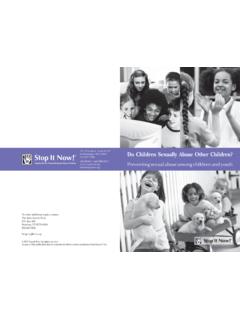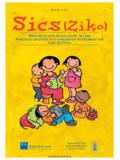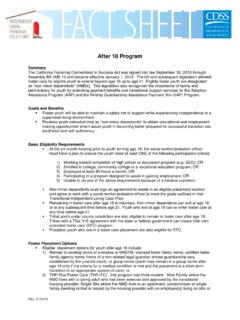Transcription of The Situation of Palestinian Children - UNICEF
1 An assessment based on the Convention on the Rights of the Child The Situation of Palestinian Childrenin The Occupied Palestinian Territory, Jordan, Syria and LebanonThe Situation of Palestinian Children in The Occupied Palestinian Territory, Jordan, Syria and LebanonAn assessment based on the Convention on the Rights of the Child2010 Table of Contents IntroductIon ..1cHAPtEr 1: tHE occuPIEd Palestinian tErrItory ..9cHAPtEr 2: Palestinian Children In JordAn ..39cHAPtEr 3: Palestinian Children In syrIA ..63cHAPtEr 4: Palestinian Children In lEbAnon ..79conclusIon ..95 The Situation of Palestinian Children in The Occupied Palestinian Territory, Jordan, Syria and LebanonINTRODUCTIONP alestinians represent the world s largest refugee population and one of its longest standing.
2 Military conflict and political turmoil stemming from the Arab-Israeli dispute have forced millions of palestinians to leave their homes and seek refuge elsewhere, many more than once. The great grandchildren of the original refugees are now parents to refugee Children , testimony of the duration of the dispute. Sadly, prospects of a just and lasting resolution of the conflict are not yet in sight. The socioeconomic hardship in which the Palestinian people have been living, whether it is in The Occupied Palestinian Territory itself or in the neighbouring countries of Jordan, Syria or Lebanon, is therefore likely to continue to be a serious challenge for the new generation in the foreseeable future. The lives of Palestinian Children in the West Bank - including East Jerusalem - and the Gaza Strip have been heavily affected by the presence of Israeli occupation forces, settlers and checkpoints since the 6-day war of 1967 between Israel and Arab States.
3 The Palestinian uprising, or intifada starting in 1987 transformed the dynamics on the ground, producing a new form of expression more violent - by young palestinians . inside the occupied territory. This was followed by the 1st Gulf war, where palestinians across the region had to bear the negative consequences of their leadership siding with the then Iraqi head of State, Saddam Hussein. A peace process was thereafter initiated, culminating in the Oslo agreements of 1993. These set a timetable for the gradual assumption of Palestinian self-rule in The Occupied Palestinian Territory (OPT), although not in occupied East Jerusalem. In 1994, the Palestinian Authority (PA) was set up as a temporary self-rule administration to govern areas of the West Bank and Gaza Strip, pending the conclusion of a final status agreement between Israel and the Oslo II implementation agreements of 1995 divided the West Bank the largest part of OPT- into three zones (Areas A , B and C ) with shared Palestinian -Israeli control in two of them but with Israel remaining in total control of Area C.
4 The latter comprises 60 per cent of the West Bank and is an arrangement still in place today. In the 15 years since Oslo II, Israeli forces have repeatedly re-occupied towns and cities in the West Bank, have carried out targeted assassinations of Palestinian leaders and have launched two full scale military offensives against the Gaza Strip, resulting in thousands of palestinians killed, tens of thousands wounded and great destruction of Palestinian institutions, homes and livelihoods. During this period, Israeli civilians were also repeatedly targeted by attacks from Palestinian 1994, the Palestinian Authority set about establishing the mechanisms of self-government and civil society, and developing a distinctly Palestinian infrastructure of institutions and social services, thus laying down the building blocks of a future state.
5 The palestinians of the occupied territory are at present separated not only geographically but by a split in leadership. The mainstream Fateh faction of the Palestine Liberation Organization dominates the Ramallah-based PA and rules the West Bank, while the Islamist movement Hamas is ruling the Gaza enclave de facto since 2007, after its win in legislative 1 The Situation of Palestinian Children in The Occupied Palestinian Territory, Jordan, Syria and Lebanon2elections in 2006 was contested by Fateh and after clashes between Hamas and Fateh over control over the enclave led to a Hamas military talks on a final status agreement have continued fitfully, the timetable set out in the Oslo agreements was not met, and Palestinian frustrations exploded in the second (or Al Aqsa )
6 Intifada in 2000, since which harsh new Israeli measures have been imposed on Palestinian lives in OPT. In 2002, Israel began construction of a Barrier, or separation wall enclosing the West Bank and along much of its route looping deep into Palestinian territory and effecting a de facto annexation of significant tracts of Palestinian land, with serious consequences on the livelihood of many Palestinian 2003, the peace process has been spearheaded by the Quartet , comprising the United Nations (in the person of the Secretary-General), the United States, the Russian Federation and the European Union, and they have laid out a Roadmap of phased implementation, based on mutual steps by both sides.
7 Few of the commitments agreed by both parties under the Roadmap have been implemented. In 2005, Israel withdrew its soldiers and evacuated illegal settlers from the Gaza Strip, but it remains in control of all but one of Gaza s border crossings and its sea, air, and telecommunications spaces, and since 2007 has imposed a near-total blockade under which the exit and entry of people and the importation of all but humanitarian goods is prevented. These developments with their impact on Children are discussed further in the OPT sections palestinians in Jordan are almost all Jordanian citizens and live and work under the protective legal and political framework of one of the more stable and forward-looking Arab governments. There are, however, different categories of palestinians in Jordan including about 100,000 refugees formerly from Gaza who do not enjoy Jordanian nationality or full rights and this has implications for the rights of Children and Syria, where palestinians comprise only about 2 per cent of the total population, they enjoy almost all of the rights of Syrian nationals and full access to education, health care, and employment.
8 However, there are still economic and social conditions and constraints that define their lives and the welfare and future prospects of their is in Lebanon where, after the occupied territory, the palestinians face the most severe constraints on their daily lives and endure the harshest living conditions, partly because of the right apparently given to the Palestinian Liberation Organisation in the Cairo agreement of 1969 to carry weapons and to engage in combat with Israel, a right that no other Arab country had granted to palestinians . The palestinians in Lebanon, most of them registered refugees but including thousands of unregistered refugees and non-ID holders who suffer particular hardship, had never been given any official status and faced severe restrictions on where they can live, or work and depend on UNRWA (the United Nations Relief and Works agency for Palestine refugees in the Near East) () for their basic needs.
9 This status has changed since August 2010, when the Lebanese parliament voted to grant registered palestinians access to the same jobs as any Situation of Palestinian Children in The Occupied Palestinian Territory, Jordan, Syria and Lebanon3 Demographic trends The Palestinian population in the region under study is characterized by a very rapid growth rate (one of the highest in the world) and the predominance of youth in the population. The majority of palestinians ( million Children and young people) are under the age of 25, and nearly 40 per cent of them ( million) are under 18. The median age is estimated at around is a slow, gradual shift in the ratio of youth-to-aged dependency among the Palestine refugee population.
10 The observed decline in fertility and infant and child mortality rates, together with increased life expectancy, will most likely result in higher dependency ratios among refugees of Children under 15 and of aged over dependency is seen as decreasing while child and aged dependencies increase. This trend will have implications for governments and other stakeholders, as demand will increase for social support services for Children and for older people this gradual demographic shift is complete, the predominantly youthful characteristic of the Palestinian population will remain, and demand will continue to increase in the near term for quality education and other youth-related services and facilities.

















